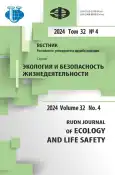Определение режима работы эжекционной флотационной установки для очистки сточных вод
- Авторы: Антонова Е.С.1, Карпикова В.О.1
-
Учреждения:
- Московский государственный технический университет имени Н.Э. Баумана (национальный исследовательский университет)
- Выпуск: Том 32, № 4 (2024)
- Страницы: 409-421
- Раздел: Промышленная экология
- URL: https://journal-vniispk.ru/2313-2310/article/view/324066
- DOI: https://doi.org/10.22363/2313-2310-2024-32-4-409-421
- EDN: https://elibrary.ru/NHSBEF
- ID: 324066
Цитировать
Полный текст
Аннотация
Рассмотрены способы повышения качества водовоздушной смеси, генерируемой эжекционной системой аэрации, используемой при флотационной очистке сточных вод, включающие использование эжекторов разных конструкций и диспергирующих устройств, изменение коэффициента эжекции и скорости истечения из сопла, применение пенообразователей. Показано, что для высокоэффективной очистки требуются пузырьки размерами порядка десятков микрометров, имеющих равномерное распределение по камере аэрации. Предложено использование системы аэрации, включающей эжектор, аэратор и диспергатор для более эффективного дробления пузырьков. Проведены эксперименты по определению параметров водовоздушной смеси (размеров пузырьков и интенсивности аэрации) при различных скоростях ее истечения из аэраторов разных конструкций. Определен режим работы, позволяющий генерировать наибольшее количество мелкодисперсных пузырьков размерами 75-115 мкм. При данном режиме работы был использован аэратор кольцевого сечения (внутренний диаметр 4 мм, наружный диаметр 6 мм), скорость истечения составила 13 м/с.
Об авторах
Екатерина Сергеевна Антонова
Московский государственный технический университет имени Н.Э. Баумана (национальный исследовательский университет)
Автор, ответственный за переписку.
Email: e.s.antonova@bmstu.ru
ORCID iD: 0000-0003-4632-7984
SPIN-код: 4540-2715
кандидат технических наук, доцент
Российская Федерация, 105005, г. Москва, ул. 2-я Бауманская, д. 5, стр. 1Вероника Олеговна Карпикова
Московский государственный технический университет имени Н.Э. Баумана (национальный исследовательский университет)
Email: karpikova01@mail.ru
студент Российская Федерация, 105005, г. Москва, ул. 2-я Бауманская, д. 5, стр. 1
Список литературы
- Ksenofontov BS. Flotation wastewater treatment. Moscow: New technologies; 2003. (In Russ.).
- Zubareva GI. Flotation in technological schemes for industrial wastewater treatment. Bulletin of PNRPU. Construction and architecture; 2019;(4):67–77. (In Russ.). http://doi.org/10.15593/2224-9826/2019.4.07
- Zhuravlev RG, Borisov BN. Identification of factors influencing the operation of aeration systems in aeration tanks. Science, education and culture, 2021;(56): 21–24. (In Russ.).
- Drewnowski J, Remiszewska-Skwarek A, Duda S, Łagód G. Aeration process in bioreactors as the main energy consumer in a wastewater treatment plant. Review of solutions and methods of process optimization. Processes, 2019;7(5):311–332. https://doi.org/10.3390/pr7050311
- Gavril’ev SA, Ivanov MV. Acoustic monitoring of the dispersed composition of air bubbles in aerated wastewater treatment processes. Issues of modern science and practice. University named after V.I. Vernadsky, 2021;(81):14–22. (In Russ.). https://doi.org/10.17277/voprosy.2021.03.pp.014-022
- Antonova ES. Intensification of the wastewater treatment process of a food plant using a flotation machine with an ejection aeration system with a dispersant. Scientific works of KubSTU, 2017;(7):63–70. (In Russ.).
- Ledyan YUP, Selivonchik VV, Shcherbakova MK. Application of jet aeration to increase the efficiency of water purification in the recycling water supply system of a foundry. Casting and metallurgy. 2008;(49):161–164. (In Russ.).
- Murtazayev FA, Mirzayev M. Analysis of wastewater aeration methods in aeration tanks. Journal of new century innovations. 2022;17(2):136–141.
- Han Y, Zhu J, Shen L, Zhou W, Ling Y, Yang X, Wang S, Dong Q. Bubble size distribution characteristics of a jet-stirring coupling flotation device. Minerals, 2019;9(6):369. https://doi.org/10.3390/min9060369
- Ksenofontov BS, Antonova ES. Research of Disperse Composition of Air-and-Water Mix Generated by Ejector Aeration System During Wastewater Floatation Treatment. Safety in the technosphere. 2016;5(4):38–44. (In Russ.). http://doi.org/10.12737/23760
- Antonova ES. Investigation of oily wastewater treatment process in a flotation set up with ejection system of aeration with disperse. Bulletin of RUDN university. Series: Ecology and life safety. 2017;25(4):548–561. (In Russ.). http://doi.org/10.22363/2313-2310-2017-25-4-548-561
- Zavodyanov II, Kapitonova SN, Ksenofontov BS. Using an ejection system for supplying water and reagent in combined flotation apparatus. IOP Conference Series: Earth and Environmental Science. Ekaterinburg. 2020;864:1–6. http://doi.org/10.1088/1755-1315/864/1/012059
- Tkacheva LT, Brench MV, Demchenko AV. Improving the quality of water for the needs of agricultural production using a gas-liquid ejector. Technical and personnel support of innovative technologies in agriculture: materials of the International Scientific and Practical Conference. Minsk: BSATU; 2019. p. 219–221. (In Russ.).
- Grinis L, Lubashevsky N, Ostrovski Y. Influence of the flow rate ratio in a jet pump on the size of air bubbles. International Journal of Mechanical, Aerospace, Industrial, Mechatronic and Manufacturing Engineering. 2015;9(7):1161–1164.
- Sazonov DV. Influence of the pump type on the parameters of the pneumatic-hydraulic aeration system in flotation apparatus. Water supply and sanitary technic. 2017;10:40–45. (In Russ.).
- Gmurman VE. Theory of Probability and Mathematical Statistics. Moscow: Higher school; 1999. (In Russ.).
Дополнительные файлы









